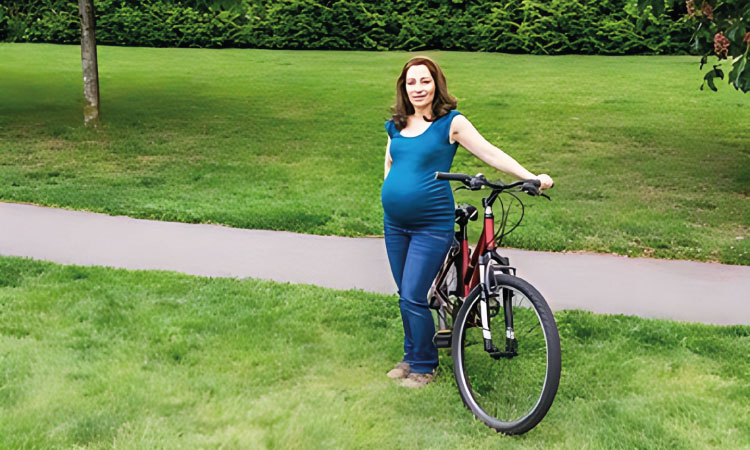Physical activity during pregnancy has several benefits. It is advantageous for both the mother and the unborn child as well. A proper exercise regimen can enhance mood, reduce discomfort, and increase overall well-being. Cycling has become increasingly popular as a form of exercise. Cycling during pregnancy is a topic that has many opinions and perspectives.
While some people consider cycling a safe and beneficial exercise for pregnant women, others consider it too risky. Pregnant women must prioritize safety and adhere to medical advice, even though cycling while pregnant has many advantages.
Is Cycling During Pregnancy Safe?
Exercises such as cycling are generally considered low-impact and gentle on the joints. As a result, it is a favorable choice for pregnant women since it reduces the risk of strain and injury. While cycling during pregnancy can be a safe and enjoyable activity for some women, it also requires a great deal of caution and care.
The pregnant woman’s health, her stage of pregnancy, and the kind of cycling she does are just a few of the variables that can affect the advantages and disadvantages of cycling during pregnancy.
Related Reading: 9 Problems Lack Of Exercise During Pregnancy Can Cause
Indoor cycling during pregnancy
Pregnancy can benefit greatly from indoor cycling, also referred to as stationary cycling or spin cycling. However, precautions must be taken, such as adjusting the intensity, duration, and bike settings to your comfort level, before trying stationary cycling during pregnancy.
In some circumstances, indoor cycling during pregnancy has advantages over outdoor cycling exercise. Some of which are:
- With the right positioning and a well-padded seat, indoor cycling can help relieve pressure on the pelvic region, which can become more sensitive during pregnancy
- Indoor cycling offers a controlled and reliable environment. You do not have to be concerned about slippery surfaces, heavy traffic, or poor weather that might make slips and falls more likely
- It makes sure you are comfortable and lowers the chance of getting too hot
- Compared to outdoor cycling, using an indoor bike offers a lower-impact workout. Pregnant women may particularly benefit from this, as it lessens joint stress and lowers the risk of injury
- Cycling indoors is advantageous for maintaining energy levels and staying hydrated during pregnancy because it makes it easier to obtain water and fruits whenever required
- Pregnancy can cause fatigue, and indoor cycling allows you to exercise without the added challenge of long distances, hills, or strong winds that outdoor cycling might entail
- Additionally, a woman who is pregnant can easily change the resistance and intensity to suit her fitness level and evolving needs
Outdoor cycling during pregnancy
If you take into account things like balance, coordination, and the state of the roads, outdoor cycling during pregnancy can be safe. Always choose well-maintained paths, wear a helmet and other appropriate gear, and get a comfortable bike.
Calculate Due Date With LMP
Compared to indoor cycling, which can occasionally feel monotonous, many expectant mothers find outdoor cycling to be more interesting and engaging. Therefore, while indoor cycling can have some benefits for pregnant women, there are also some benefits to outdoor cycling that some expectant mothers may find appealing.
The following are a few factors that may make outdoor cycling during pregnancy seem more thrilling:
- When you cycle outside, you can take advantage of the clean air and direct sunlight, which can boost your mood, give you more energy, and help your body make vitamin D. For the health of your bones and overall well-being, you need enough vitamin D during pregnancy.
- There are stress-relieving advantages to being outside and surrounded by nature that may not be present indoors. It can help to reduce pregnancy-related anxiety to spend time in nature
- Because it requires balance, steering, and the ability to traverse a variety of terrains, outdoor cycling uses a wider range of muscles. This might offer a more thorough workou
Related Reading: Probiotics During Pregnancy- A Complete Guide
Cycling during the first trimester
According to our panel gynaecologist Dr Ankita Patel Tayal, cycling during the first trimester of pregnancy is usually safe for women who are seasoned cyclists and have no health problems. Opt for gentle routes with smooth surfaces to reduce any risks associated with balance and jarring movements. The moment you feel uneasy, lightheaded, or have any other strange symptoms, stop cycling.
Cycling during the second trimester
Cycling is often comfortable and enjoyable for many pregnant women during the second trimester due to their improved balance and increased energy. Cycling (both indoor and outdoor) during the second trimester of pregnancy is generally safe for women who have had a healthy pregnancy without complications and whose healthcare provider has given them the OK to exercise.
But it is important to pick well-kept, smooth paths, drink plenty of water, and modify your bike’s setup to fit your evolving body.
Cycling during the third trimester
Cycling should be done with caution and under a doctor’s supervision during the third trimester of pregnancy. There may be a higher risk of falling as your body experiences significant changes and your center of gravity changes. Pregnant women should drink plenty of water, take flat, low-traffic routes, and pay close attention to their feelings and energy levels.
A pregnant woman may consider using a recumbent bike or a stationary bike if she wants more stability. Additionally, be prepared to stop cycling altogether or reduce your intensity if you experience any pain, discomfort, or contractions. Prioritizing safety and regular communication with your healthcare provider is paramount during this stage.
Benefits Of Cycling During Pregnancy

Cycling provides a low-impact form of exercise that is gentler on the joints compared to activities like running, making it a more comfortable option during pregnancy. Depending on a variety of factors, the time frame for cycling during pregnancy can vary from one person to another. When considering whether to start or continue a cycling routine during pregnancy, pregnant women should consider their physical and emotional condition, their doctor’s advice, and their trimester.
Here are some potential benefits of cycling during pregnancy:
- Engaging in regular physical activity like cycling can lead to better sleep quality, which is often challenging during pregnancy
- Cycling works a variety of muscle groups and helps keep pregnant women’s muscles strong and toned
- Gentle cycling movements can encourage better circulation, potentially reducing swelling in the legs and ankles, a common concern during pregnancy
- Cycling can help improve cardiovascular fitness, promoting better blood circulation and heart health for both the mother and the developing fetus
- By burning calories and promoting general fitness, cycling can support healthy weight management during pregnancy
- Cycling promotes healthy digestion and can alleviate common pregnancy-related digestive discomforts
Related Reading: Top 10 Activities To Avoid During Pregnancy
Risks of Cycling During Pregnancy
Being physically active during pregnancy has many advantages. Yet, it’s important to consult with your doctor before engaging in any physical activity, including cycling, while pregnant.
Here are some potential risks of cycling during pregnancy, along with the reasons behind them:
1. Risk of overheating and dehydration
Pregnant women are more susceptible to overheating and dehydration due to hormonal changes that affect the body’s ability to regulate temperature1. Cycling in hot weather or for extended periods could increase the risk of these issues, which could impact both the mother and the baby.
2. Risk of compression of the blood vessels
As the uterus grows, it can compress blood vessels, potentially affecting blood flow to and from the lower extremities2. Prolonged cycling might exacerbate this compression and lead to discomfort or swelling in the legs.
3. Risk of falls and abdominal trauma
Due to their shifting centers of gravity, fluctuating hormone levels, and loosening of ligaments, pregnant women may notice changes in their balance and coordination. These raise the possibility of falling while cycling, which could cause injury to the mother as well as the fetus.
In pregnancy, the abdomen expands to accommodate the growing fetus, and the uterus becomes more vulnerable to external pressure and impact. When cycling, a fall or impact could result in direct trauma to the abdomen, which may harm the unborn child.
4. Risk of strain
A woman’s comfort and flexibility on a bicycle may decrease as her pregnancy progresses due to her expanding belly. This might result in bad posture and added stress on the neck and back. Ligaments become more relaxed as a result of pregnancy hormones, which weaken the stability of joints. The repetitive motion of cycling may put a strain on these already-vulnerable joints and ligaments, possibly resulting in injuries.
Related Reading: Can Skipping During Pregnancy Cause A Miscarriage?
5. Risk of Preterm Labor
Intense or strenuous exercise, including vigorous cycling, may trigger contractions and potentially contribute to preterm labor in some cases. This risk is higher for women with a history of preterm labor or other complications.
6. Prolonged cycling increases the risk of fetal oxygen deficiency
Intense or prolonged exercise, such as rigorous cycling, could divert blood flow away from the uterus and placenta, potentially reducing oxygen and nutrient supply to the fetus. (source). This can be a concern, especially during the later stages of pregnancy when the demands of the growing baby are higher.
7. Possibility of worsening pelvic discomfort
Cycling can put pressure on the pelvic region and may make pelvic pain, which is frequent during pregnancy, worse. Pressure like this could not only cause pain or discomfort but also contribute to conditions like pelvic girdle pain.
8. Risk of perineum stress
Cycling can put pressure on the perineum, which is the area between the anus and the genitalia. This pressure occurs mainly due to the design of the bicycle saddle and the position of the body while cycling.
The perineal pressure can cause discomfort and, in some cases, lead to more serious issues such as numbness, tingling, and even nerve compression. During pregnancy, the perineal area becomes more sensitive, and blood flow to the pelvic region increases, which can make it even more prone to discomfort and pressure.
Precautions To Be Taken While Cycling During Pregnancy

Dr Ankita Patel Tayal, practising obstetrician & gynaecologist since 10 years, says that cycling during pregnancy can be a rewarding way to stay active and healthy, but it also requires some extra care and caution. It is critical to speak with your doctor before beginning any exercise program during pregnancy, including cycling, to ensure that it is safe for your health condition and stage of pregnancy.
Related Reading: Stomach Tightening During Pregnancy
If you are planning a bicycle ride outside, here are some outdoor cycling precautions when expecting:
- Consult your healthcare provider: To make sure that cycling is safe for you and your unborn child, talk to your doctor before getting on your bike. They can evaluate your general health and offer advice based on any complications you may be experiencing during pregnancy
- Maintain a comfortable pace: Cycling can be a strenuous activity, but you should be careful not to overdo it while pregnant. Pregnant women are advised to exercise at a heart rate that is between 60 and 80% of their maximum, or typically no more than 140 beats per minute as per this source. The “talk test” is another technique for gauging effort; if one can carry on a conversation while cycling, they are probably exerting themselves safely
- Choose the appropriate bike and properly adjust it: Opt for a comfortable and properly fitted bike. You will experience changes in your body as well as in your comfort and balance as your pregnancy progresses. To meet your evolving needs, you might need to modify the handlebars, pedals, or gears on your bicycle
- Particularly in the later stages of pregnancy, you might also want to switch to a more stable bike, like a recumbent bike or a stationary bike. Aim for a moderate intensity level, ensuring you can maintain a conversation while cycling. Avoid pushing yourself too hard or becoming breathless
- Safe ride: Cycling outdoors can be risky, as many factors can cause you to lose balance and fall off the bike. This may cause abdominal trauma, which could be harmful to your unborn child. To reduce vibrations and jolts, stay on flat, smooth surfaces.
- Avoid bumpy trails, uneven terrain, and high-impact activities that could risk falling. Also, it is important to wear a well-fitted helmet and other protective gear, such as gloves, elbow pads, and knee pads, when cycling outdoors. Wear comfortable, loose-fitting clothing and proper footwear
- As your pregnancy progresses, your center of gravity changes, making you more prone to balance issues. Be cautious and avoid sudden movements or rapid turns
- Avoid Overheating and Stay Hydrated: Cycling in hot and humid conditions can lead to overheating. Choose cooler times of the day and dress in breathable clothing to prevent overheating. Drink plenty of water before, during, and after cycling to stay hydrated, especially in warmer weather
- Listen to your body: Pay attention to how your body feels during and after cycling. If you experience any discomfort, pain, dizziness, shortness of breath, or other unusual symptoms, stop cycling and consult your healthcare provider. In the later stages of pregnancy, you may experience pelvic discomfort or pain. If cycling exacerbates this discomfort, consider switching to a more comfortable form of exercise. If you’re feeling fatigued, it’s okay to take a break or stop your cycling session. Your body’s energy levels may fluctuate during pregnancy.
When Should I Stop Cycling During Pregnancy?

Many pregnant women find that cycling is a healthy form of exercise because it keeps them physically fit, boosts their cardiovascular health, and promotes general well-being. However, there are some situations in which it might be best to stop cycling during pregnancy or at the very least seek advice from a medical professional:
- Cycling can sometimes lead to discomfort or pain in the pelvic area due to pressure on the pelvic floor and surrounding muscles. If you experience significant discomfort while cycling, it’s a sign to consider stopping
- In case of multiple pregnancies, the added weight and strain on your body might make cycling less comfortable and potentially riskier
- If you experience severe back or joint pain while cycling, it is better to stop
- In the event of vaginal bleeding, spotting, or other unusual symptoms, it’s important to stop cycling
- If you have a history of pregnancy-related medical issues like high blood pressure, preeclampsia, gestational diabetes, placental issues like placenta previa, or any other condition, talk to your doctor before you continue cycling
- If you’re at risk of preterm labor, it is better to avoid strenuous exercises like cycling to reduce the risk of triggering early labor
- Last but not least, if you find that cycling exhausts you or leaves you feeling excessively tired, it might be a sign to cut back or stop
Conclusion
Always consult your doctor before beginning or continuing a cycle while pregnant, and take all necessary precautions to safeguard both you and your unborn child. Cycling can be a fantastic way to stay active and healthy during this important time in your life, but it is not worth putting your health or the development of your unborn child in danger. We hope that this blog will enable you to make an informed choice about cycling while pregnant.

